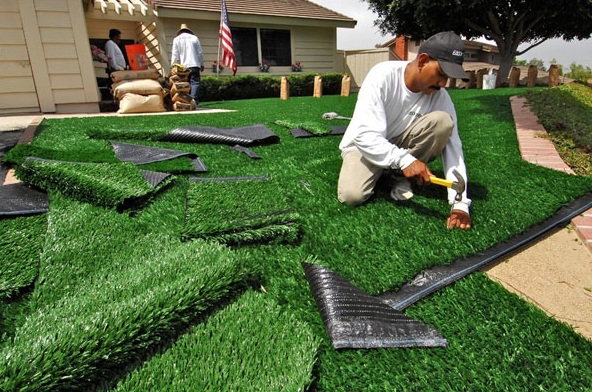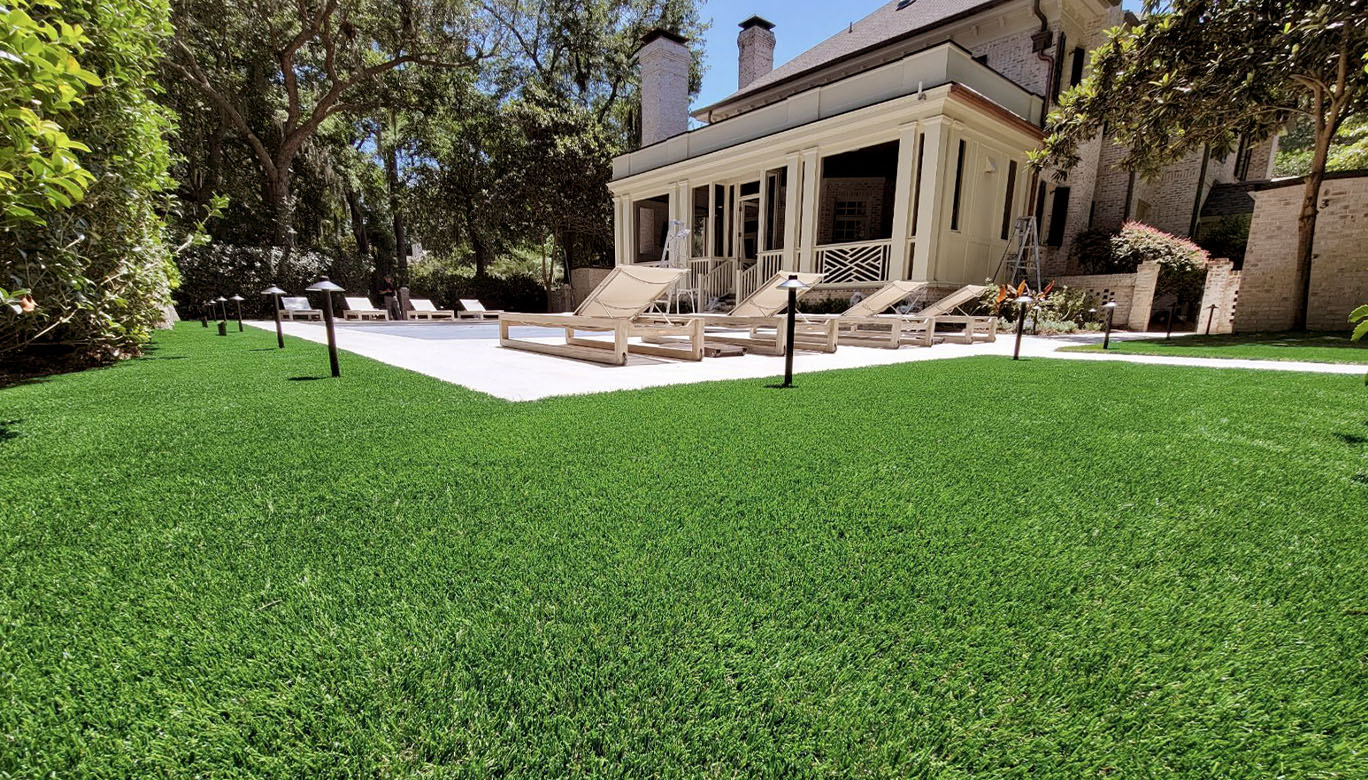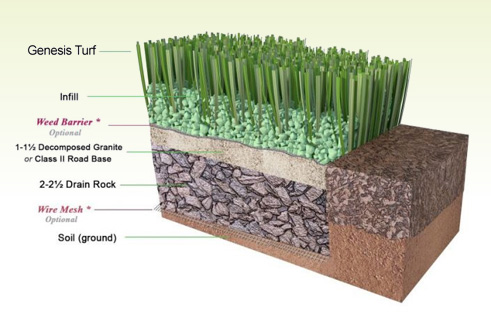Choose the Best Artificial Turf Companies Phoenix for Your House or Commercial Space
Choose the Best Artificial Turf Companies Phoenix for Your House or Commercial Space
Blog Article
Explore the Environmental Advantages of Opting for Artificial Grass Solutions
The adoption of fabricated turf remedies offers a compelling possibility to address pressing environmental obstacles. By substantially lowering water use and lessening the application of damaging chemicals, these choices not just advertise lasting landscaping yet likewise shield regional ecosystems.
Water Conservation Conveniences
Among one of the most significant advantages of synthetic turf is its capacity to preserve water. Traditional grass lawns require substantial irrigation, specifically in locations vulnerable to dry spell or water limitations. In comparison, synthetic turf does not need watering, substantially minimizing the total need for water sources. This attribute is specifically advantageous in deserts where water deficiency is a pressing worry.
By getting rid of the requirement for routine watering, synthetic grass adds to sustainable landscape practices and assists minimize the environmental impact of too much water consumption. In addition, the conservation of water includes the reduction of overflow, which can bring about dirt erosion and waterway contamination.
In addition, the installation of synthetic grass allows house owners and towns to designate water sources extra effectively, concentrating on essential uses such as drinking water and farming. The shift in the direction of artificial lawn not only advertises responsible water use yet also straightens with more comprehensive environmental objectives focused on protecting natural resources.
As areas progressively prioritize sustainability, the water preservation benefits of synthetic grass provide a compelling instance for its fostering in commercial and domestic landscaping tasks.
Lowered Chemical Use
The change to synthetic grass substantially decreases the reliance on chemical treatments generally used in natural grass upkeep. Typical turf monitoring commonly entails the application of pesticides, herbicides, and plant foods to promote development and control pests. These chemicals can posture threats to human health and wellness, regional wildlife, and the setting, contributing to dirt and water contamination.
In contrast, man-made lawn removes the requirement for these damaging substances. By lessening the release of synthetic substances right into the community, man-made lawn advertises healthier soil and water systems.
Furthermore, the lack of chemical overflow connected with synthetic grass installments aids secure neighborhood rivers from air pollution, sustaining marine life and keeping biodiversity. Phoenix turf companies. As neighborhoods increasingly focus on lasting practices, choosing synthetic grass offers a feasible solution that lines up with ecological conservation objectives. With this shift, building proprietors can enjoy lush environment-friendly areas without jeopardizing ecological wellness, leading the way for an extra lasting future
Lower Carbon Footprint

Furthermore, the setup of synthetic lawn can result in considerable water conservation. Natural yards call for considerable quantities of water for irrigation, which not only contributes to the site link carbon impact related to water extraction and therapy but likewise strains regional water sources. On the other hand, synthetic grass requires minimal upkeep, calling for no watering, thus considerably lowering water usage and its associated energy expenses.
In addition, the long life of artificial turf adds to its decreased carbon influence. With a life-span of approximately official source 15 years or more, the need for frequent replacements is lessened, leading to less waste and lower energy consumption in production and taking care of traditional grass alternatives. On the whole, synthetic grass presents a sustainable option for environmentally mindful landscaping.
Habitat Preservation
Environment conservation is an important factor to consider in the argument over landscaping selections, specifically when comparing fabricated lawn to natural turf. Natural turf lawns commonly need substantial maintenance, consisting of using chemicals, fertilizers, and herbicides, which can negatively affect regional environments. These chemicals can leach right into the soil and rivers, harming indigenous plants and fauna and interfering with regional environments.
In contrast, synthetic grass provides an opportunity to decrease the ecological impact of landscaping. By choosing artificial turf, property owners can decrease the interruption of all-natural environments related to conventional yard treatment techniques. Synthetic grass removes the requirement for damaging chemicals, therefore shielding nearby wild animals and keeping the integrity of surrounding ecosystems. The installation of fabricated grass can lead to the conversion of former yard areas right into even more biodiverse landscapes, such as pollinator yards or indigenous plant areas, which can support neighborhood wild animals.
Eventually, the change to fabricated grass not just preserves water and lowers upkeep efforts however likewise fosters a much more harmonious connection in between human activities and the all-natural atmosphere, advertising habitat preservation at the same time.
Long-Term Sustainability
Long-lasting sustainability is click here for more info an important factor in assessing the benefits of synthetic grass over standard lawn lawns. One of one of the most substantial advantages of synthetic grass is its longevity; it can last as much as 15-20 years with minimal upkeep, whereas natural lawn needs regular reseeding and substitute. This long life minimizes the demand for continuous resources, such as water, plant foods, and pesticides, which are important for keeping a healthy turf yard.
Furthermore, synthetic grass adds to a reduction in carbon exhausts connected with yard care tools. Traditional grass typically call for gas-powered mowers, trimmers, and blowers, every one of which add to air contamination. Arizona artificial turf. In contrast, synthetic grass eliminates the need for such devices, promoting a cleaner environment
Additionally, the production of synthetic grass increasingly uses recycled materials, boosting its sustainability profile. As suppliers embrace eco-friendly practices, the ecological footprint of synthetic grass remains to decrease.

Final Thought
The fostering of man-made lawn options presents considerable environmental advantages, including considerable water preservation, minimized reliance on hazardous chemicals, and a lower carbon footprint. Man-made turf aids in preserving all-natural environments by lessening land disruption and advertising lasting sustainability with the use of durable products. Collectively, these variables emphasize the potential of synthetic lawn to add positively to environmental wellness and offer a practical choice to conventional landscaping practices in a progressively resource-conscious globe.
In comparison, man-made lawn does not need watering, substantially reducing the total need for water sources. By decreasing the release of artificial substances right into the ecosystem, synthetic lawn promotes healthier soil and water systems.
Additionally, the installation of artificial lawn can result in substantial water conservation. In comparison, artificial lawn requires very little maintenance, needing no watering, thus substantially lowering water use and its connected power prices.

Report this page